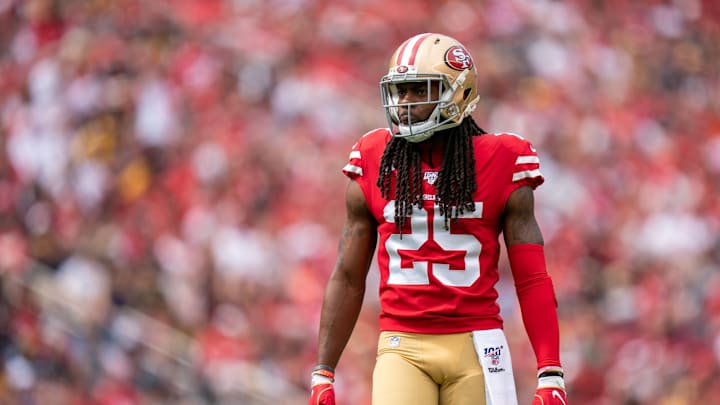Richard Sherman's Strengths and Weaknesses at 32

Richard Sherman just had one of his best seasons in the NFL, but he also suffered two humiliations in the 49ers’ final two playoff games.
What should we make of the 32-year-old cornerback?
In the NFC Championship game, Sherman gave up a 65-yard catch to Packers wide receiver Davante Adams. And in the Super Bowl, with the season on the line, Sherman gave up a 38-yard catch to Chiefs wide receiver Sammy Watkins, who ran the same route Adams ran when he beat Sherman in the previous game. These were the first two times receivers had burned Sherman deep all season.
What happened?
What did Sherman do so well all season to earn his first Pro Bowl selection since 2016? And what did opponents see on film from Sherman which they eventually exploited?
Let’s examine his strengths and weaknesses at this advanced stage of his career.
STRENGTH: ZONE COVERAGE
Sherman probably is the smartest cornerback in NFL history, which makes him perfect for zone coverage.
Zone coverage allows Sherman to keep his eyes on the offense -- he doesn’t have to turn his back to the action and chase a young, athletic wide receiver. He can focus on the ball and use his smarts and experience to anticipate where the quarterback will throw. No cornerback anticipates better than Sherman.
When Sherman intercepts a pass from zone coverage, he typically breaks toward the pass before the wide receiver. You would think Sherman was in the offensive huddle and heard the play before it began. But he simply has seen everything before, because he has experience and he used to play offense. He was a wide receiver in high school and his first three seasons at Stanford.
STRENGTH: TACKLING
You can tell Sherman used to play wide receiver when you watch him in zone coverage -- he often knows what the offense will do before the offense does it. But you can’t tell Sherman used to play wide receiver when you watch him hit. He hits like a strong safety, not a cornerback who used to play wide receiver.
One of Sherman’s best plays of last season was a tackle. He might not remember it, and you almost surely don’t, but the tackle was important. The 49ers were playing in Los Angeles and the Rams had the ball at the 49ers’ five-yard line. Both teams had seven points. The Rams were about to take the lead.
Jared Goff handed off to Darrell Henderson, who had a clear path to the end zone -- the only man who stood in his way was Sherman. Henderson just needed to run over a cornerback. No problem, right?
Wrong. Sherman tackled Henderson at the one-yard line, and the Rams never scored during that drive. The 49ers won that game. Sherman’s tackle was the turning point.
WEAKNESS: MAN-TO-MAN COVERAGE
Opposing wide receivers eventually figured something out.
If they give Sherman a hard jab step to the outside at the line of scrimmage when he plays man-to-man coverage, he becomes extremely vulnerable to the inside.
Why?
Because Sherman has a surgically-repaired Achilles tendon, and players who recover from that injury might regain most of their speed, but they typically lose their breaks, or their ability to stop quickly and change directions. Those movements become extremely tough. In the back of the player’s mind, he fears he might tear his Achilles again if he stops too violently.
So in the NFC Championship game when Sherman faced Adams man to man, Adams gave Sherman a convincing jab step to the outside, Sherman fell for it, turned his hips and gave up a 65-yard catch. Two weeks later in the Super Bowl, Watkins used the same technique to beat Sherman for a 38-yard game. And the 49ers lost.
Sherman’s issues in man-to-man coverage won’t go away next season. The 49ers simply will have to work around his weaknesses and call lots of zone coverage, because he still is the best zone corner in the game, and the best zone corner of all time.

Grant Cohn has covered the San Francisco 49ers daily since 2011. He spent the first nine years of his career with the Santa Rosa Press Democrat where he wrote the Inside the 49ers blog and covered famous coaches and athletes such as Jim Harbaugh, Colin Kaepernick and Patrick Willis. In 2012, Inside the 49ers won Sports Blog of the Year from the Peninsula Press Club. In 2020, Cohn joined FanNation and began writing All49ers. In addition, he created a YouTube channel which has become the go-to place on YouTube to consume 49ers content. Cohn's channel typically generates roughly 3.5 million viewers per month, while the 49ers' official YouTube channel generates roughly 1.5 million viewers per month. Cohn live streams almost every day and posts videos hourly during the football season. Cohn is committed to asking the questions that 49ers fans want answered, and providing the most honest and interactive coverage in the country. His loyalty is to the reader and the viewer, not the team or any player or coach. Cohn is a new-age multimedia journalist with an old-school mentality, because his father is Lowell Cohn, the legendary sports columnist for the San Francisco Chronicle from 1979 to 1993. The two have a live podcast every Tuesday. Grant Cohn grew up in Oakland and studied English Literature at UCLA from 2006 to 2010. He currently lives in Oakland with his wife.
Follow grantcohn